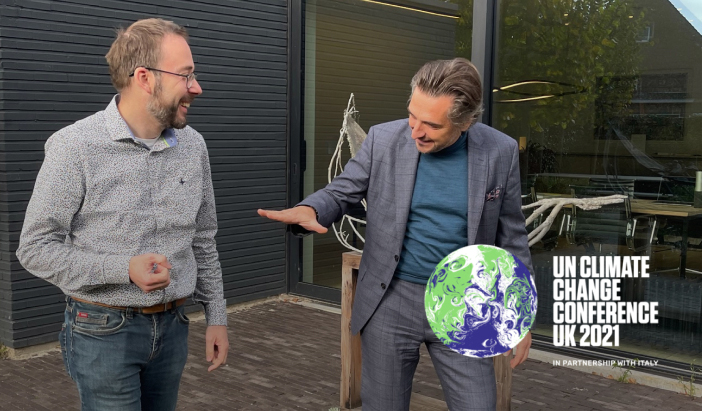
#COP26 Takeaways.
These days, climate politics are in the spotlight once more. The climate conference in Glasgow has just come to an end, and the Flemish government has finally presented its climate plan. However, the question remains to what extent such plans will have the desired effect if they do not take the day-to-day reality of regular citizens into consideration. Is there any way of estimating whether climate measures will ultimately have the desired effect?
The new Flemish climate plan is not accepted at face value. Critical voices come mainly from politicians and from civil society. One general critique amounts to the observation that the individual measures lack consistency and clear policy choices. After all, how can a government convince people to stop heating their homes with gas and to opt for sustainable alternatives, if the same government chooses gas-fired power stations to generate electricity? Apart from a lack of clear choices, there is also some criticism about the practical feasibility. The plan makes individual citizens responsible for difficult choices about sustainability and renovation, and it misses opportunities to support families in the practical (financial) feasibility of these renovations. Difficult choices for citizens, too few social measures, ... In short, too little account is taken of the daily reality of the average Flemish citizen. This leads to demotivated people who, eventually, drop out.
Anthony Iudicello, Managing Director at Pàu: "Despite the somewhat unfortunate debate in Flanders, there are a number of interesting take-aways from Glasgow #COP26. Unlike previous editions, 'innovation' is central to the conference. For example, Tech For Our Planet was launched, a hackathon where digital companies get the chance to pitch their software solutions in tackling climate challenges.
The objective is always to visualize data in a crystal clear way. Translating insights based on energy consumption and carbon emission data into user-friendly apps, tools and platforms is quite a challenge. Offering easily accessible technology that is adapted to the end users’ environment is essential here. This last aspect is one of the important priorities in digital product development offered by Pàu. This is something I am happy to discuss with Pàu's Strategy Team."
Making Desired Behavior as Simple as Possible
Jan Derboven, User Experience Researcher at Pàu, shares his ideas about a human-centered climate policy: "The problem is often not so much in the - well-intentioned - content of the political decisions, but rather in their implementation. After all, you don't achieve desirable behavior by simply imposing it, but by making the ideal behavior as simple as possible. That is behavioral design: using design to shape and direct human behavior. If you make the desired, sustainable behavior frictionless and easy, people will also make these sustainable choices. The past has shown that this approach also works in practice. Back in 2009, the U.S. government installed the "Cash for Clunkers" initiative, which allowed people to trade in an old car for a voucher offering a discount of up to $4,500 on a new, more energy-efficient car. A simple exchange, with little administrative burden. This simple exchange resulted in a particularly successful initiative: the planned budget was spent within one single week."
Making the desired behavior as easy as possible: it’s a beautiful principle, but unfortunately, not always as easy as it sounds. Making something 'as easy as possible' assumes that you have a good clear view of the life of your target audience, of the choices they make, and the thresholds that prevent them from making more sustainable choices. This insight is sometimes lacking. You don't get that insight in meeting rooms or from statistics, but only by doing - human-centered - user research with your target audience: talking to people, empathizing with their daily reality, seeing with your own eyes where the opportunities and limitations are.
Policy Choices as Part of a Customer Journey
Politicians often rely on experts from interest groups to gather insights, which in itself is not a bad strategy. When there is a lack of time and resources, experts are the best way to still get the right insights. However, what happens next often undermines the insights of the experts. In looking for a compromise, different elements put forward by different experts are combined into a mishmash of measures. As such, everyone feels heard in one way or another.
However, it could be a better strategy to not just stitch these individual insights together, but to analyze how they fit together. In the IT world, it is a common practice to build 'customer journeys': visualizations of the journey that a user goes through when using a product. Based on such a journey, it becomes evident whether a certain aspect of a product makes sense for a certain type of user or not. This approach translates seamlessly to other domains. Could a climate measure aimed at one particular target group also work for another group? If not, can we modify it, ensuring that the desired behavior does indeed become the simplest choice for various target groups? By mapping the 'customer journeys' of different groups in society in this way, you can get a better understanding of what does make sense, and what doesn’t. In this way, the mishmash of measures becomes a well-thought-out policy, with a clear link between policy choices and the day-to-day reality in which people live.

Keep It Simple, Stupid
"Such a human-centered approach can be an important stimulus to really get climate measures off the ground. What stops people from taking public transport instead of driving their cars? Can subsidies for renovation be made available in a simpler way, without long searches on complicated government websites, and without excessive administrative burden? What are the practical obstacles that stop people from renovating their homes? Do they apply to all people, or to specific groups? And how can those obstacles be removed so that the sustainable choice is also the easiest one? These are important questions that can make the difference between successful and failed measures. Make the desired choices also the simplest one. In the end, it’s just another way of referring to the famous KISS design principle. Keep It Simple, Stupid", concludes Jan Derboven.
Successful climate policy is not necessarily a matter of imposing the right rules and developing an expensive communication campaign to explain them. What do we need instead? A good understanding of the daily reality of the target group, and the right human-centered approach to turn desired, sustainable behavior into the easiest choice.

